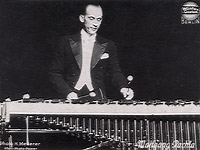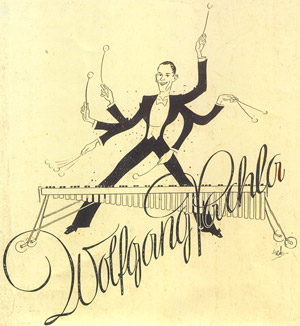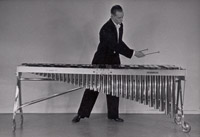Wolfgang Pachla’s style and means of achieving recognition for the Marimba-Xylophone.
"Ein Marimba-Virtuose nennt er sich schlicht. Großes musikalisches Können ist erforderlich, um dieses Instrument so zu spielen wie Wolfgang Pachla"
"He simply called himself a Marimba virtuoso. Considerable musical
capabilities are required in order to play like Wolfgang Pachla"
It is only in the present day that Wolfgang Pachla has had his instrument, the Marimba-Xylophone, accepted as an artistic instrument in its own right. He was able, on the one hand, to achieve popularity and well-paid performances at the varietés, but he wanted the Marimba-Xylophone to have a more prestigious position and for him to be accepted as a musician and artist and not as a mere entertainer.
Superficial gestures in performance would not have suited this. One exception and compensation was to perform in a darkened room with shining (phosphorous) beaters. This occurred, along with other venues, in the Wintergarten Berlin. He was thereby able to demonstrate his technical virtuosity.
In order to underpin his ambition, he was very particular about his stage presence. He always wore tails with fastidious correctness and all traditional details including a stiff collar, or occasonally a dinner suit. He did not move to incite applause when he performed, but used his technique to imply that even the most complicated technical passages entirely straightforward. His instrumental qualities were supposed to be heard and not be a show. This was the opposite of an esteemed colleague of his, Kurt Engel, who achieved success on the Marimba by comic virtuosity. Kurt Engel was also 1st timpanist in the RIAS Orchestra and later a teacher at the Hochschule in Berlin.
The demise of the Varietès in Germany after the war and the period thereafter coincided with an increased superficiality of the popular music that was the "Zeitgeist" way of thinking of the 50's. The Americans brought a number of jazz elements to Germany, which gave new impulses to the Marimba-Xylophone and especially to the Vibraphone, but degraded Wolfgang Pachla's instrument from a solo instrument to a mere ensemble instrument. He was very unhappy with this situation and although a number of dance and popular music arrangements from that period gave him a solistic part, they were for him an artistic disappointment.
New solo works for Marimba were rare and his engagements were more for classical contemporary music as an ensemble player and not specifically for his instrument. His tours to Scandinavia were in retrospect an inspiration to him.
The Marimba was more highly considered and the Radio Corporations owned wonderful American and English instruments with which he was able to experiment and to perform. He really enjoyed performing in Scandinavia with their extremely versatile musicians and flexible ensembles that were able to enthusiastically react to anything he did. He reanimated his old favourites and was very enthusiastic as to how these musicians performed modern popular music.
He did not wish to have his back turned to progress, and was in contact with various Scandinavian percussionists. This included Ib Jarlkov and Bent Lyloff from Denmark, and especially the contact with the Finnish player Rainer Kuisma made him realise that the logical consequence to his path, was to perform the Milhaud and Creston concertos on his instrument. Rainer Kuisma became later a teacher and a solo timpanist in Sweden in the orchestra in Norrköping.
The performances and recordings were again artistic highpoints. Both Milhaud's concerto, that required a lot of new techniques, and Creston's more traditional concertino, were highly motivating for him. He was finally asked to put all of his experience into writing. He registered the considerable interest in his publication during the last years of his life, which rounded off his career, despite his hopeless battle against cancer.
His Technique
Two-mallet technique
Because Wolfgang Pachla developed his technique using a four-rowed Xylophone, which supported his selection of works as a virtuoso, he became a specialist for the two-mallet technique. This technique was finely tuned and optimized in its patterns of movement. He used a considerable amount of practice time to find an elegant solution for overcoming large distances to achieve the best possible sound for the difficulties. This preparation combined with his marvellous musical instinct and artistic
tradition, resulted in a virtuoso career that was convincing and enthusiastically received by his audiences and the critics.
His Tremolo, that was able to prolong the note lengths, was tight, and depending on the context relaxed or very expressive. It was considered to be a trademark of his. He thought it to be a means of expression and not a stunt. He was able to achieve beautiful cantabile phrases that were unexpected on this instrument. He especially liked the lower octaves of selected pieces, when he used four mallets. The tremolo in this case was actually a two-mallet one with repetitions between both hands. The tempo for these low, four-mallet passages was unobtrusively, and instinctively reduced.
He had to considerably improve his Four-mallet technique in order to play the Milhaud concerto. On the other hand the tremolo technique with beat repetitions within each hand that is commonly used today was not an option for him. He believed that the advantages of the resulting relaxedness would be out weighed by the loss in intensity compared with his tremolo.
He kept himself well informed about American techniques and was impressed by their six-mallet technique. However he did not see any practical use for this either in concert or in his repertoire.
His mallet preferences included a range of soft and from woollen to thread covered ones (for the lower octaves), to moderately hard rubber mallets for more virtuosic passages. A piece such as "Der Jongleur" from Ernst Toch was an exception. In this piece the wooden character was portrayed and enhanced by using hard (horn or pyraline) mallets. His sound was a combination of his mallet selection and his refined technique.
He got to know the vibraphone in the 50's and mastered its pedal technique. It was also in this case seldom that he chose very hard beaters.






